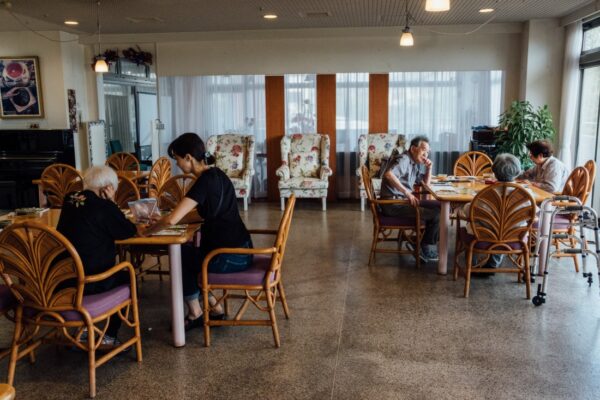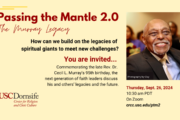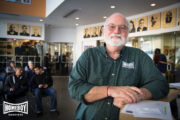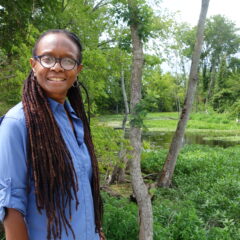This article was originally published in Inkline, with the support of CRCC’s global project on engaged spirituality.
Masue Katayama, an 80-year-old social entrepreneur, has spent her entire life, changing the childcare and nursing care system in what is today the most aged country in the world.
During the 1980s, there were only two options available for nursing care: luxurious private facilities that very few people could afford, and a cheaper option which did not represent a place where the Japanese would want their parents to spend the last days of their lives.
Back then, Masue came up with the idea to buy abandoned buildings and hire people excluded from society to create an affordable network of nursing homes. Nursing homes that fulfilled the International Organization for Standardization (ISO) standards, and actually felt like home, embellished with handmade curtains by Masue and other decorative items.
“At church, there was this sister that I was very close with. One day, she got hospitalised, and when I went to visit her, I found her very sad in the gloomy hospital environment. I wanted to do something to make her happy. And, I am someone who always strives to find solutions to problems.” Masue remembers where the idea of creating homely nursing care facilities came from.
Fast forward twenty years, the Japanese government has established a mandatory insurance programme that provides benefits to government-supported facilities for the long-term care of older persons.
This is when Masue sold her private nursing homes to Benesse Corporation and established Social Corporation Shinko Fukushikai. Her daughter, Seiko Adachi, is the director of Shinko Fukushikai. Together, they continue to search for ways to make nursing care more comfortable for their clients as well as their workers.
We talk to the mother-daughter duo to find out more about the organisation and their efforts in the Japanese nursing care industry.
INKLINE: Nursing homes that you create are more like community spaces where different generations can come together. Why is this important to you?
Masue Katayama: When I create nursing homes, I’m constantly thinking about it as a place where children and other members of the family can get together. I do not want to label these places as only for old people or being some deluxe kind of place.
For example, any young person can come to our nursing homes and have a cup of tea, or a child can come and there’s a place for him to play. I want to create spaces where people feel comfortable, where people can naturally be who they are without being aware of it. Human-centric spaces!
I: Has it been challenging creating such places in Japan?
M: In Japan, things are always guided by laws and rules. For example, if you’re trying to build a nursing home, there are rules for how wide the halls have to be for two wheelchairs to pass, rules dictating how many baths patients receive in a week, and how many meals we have to provide in a day.
Everything is regulated. But these rules are not necessarily in tune with what clients and their families want and need. That is why I’m always slightly off from what the government is dictating, whether it is in regards to nursing homes or childcare facilities. I am focusing on people’s needs. And so, I can develop and grow. And it often happens that the government says, ‘Okay this does not fit the standards, but everybody says it is convenient’.
I: One of the main challenges in this sector is the low income of nursing home employees. What are you doing to overcome this?
Seiko Adachi: Caregiving professions are not seen as well-paid jobs. It used to be a job that was performed by family members. My mother always tells me that her mission is to make sure her employees earn 10 million yen (100,000 dollars) a year. But the majority of our employees earn less than half of it.
The challenge we face as a social corporation is that the insurance system has set fixed prices for all services. So if we have 52 facilities and all are full, that means that our total revenue is fixed, we cannot earn more, which means the salary of our employees cannot go higher.
This is why my mom is trying to make a profit from other businesses. She is trying to sell her knowledge, know-how, and experience. Over her long career, she has created a sort of manual on how Shinko Fukushikai works and we have started counselling services for clients from other countries like China and Taiwan who are inspired by our work. We hope to be able to raise the salaries of our nursing home employees through this endeavour.
I: Another challenge for the nursing care industry is employment, the lack of workers. There are voices saying that employing immigrants can be a potential solution. Despite all the complications, you have been employing immigrants and even refugees. Do you think they can fill the gap?
M: If we are just trying to fill the gap of labour shortage, we are not going to succeed in doing that. The labour shortage can be solved with laws. Working with immigrants is more about learning about other cultures and our open-mindedness towards them. We have to treat them as equals.
I: You gained the inspiration for your business, and even the idea of employing immigrants, from your church. Could you elaborate?
M: Our church is a really small congregation, but if everybody saves like ¥5 every day, we can come together and create something. This is something that has inspired me in organising my business too. I apply my learnings from my church to different aspects of my company.
It was at church that I learnt cooking, and about the importance of eating together. Every Wednesday, when we have team meetings, I cook for my colleagues and we eat together as a group.
I: Doing things together is a very strong feature of your business. You have even encouraged your colleagues to perform a musical together, in an attempt to try and reduce the stigma that is still present regarding nursing homes in Japan.
M: I like to do things that we’ve never done before together. More than 2,000 people came to watch the musical and they were all crying through it. They even paid to watch it! I hope we’ve managed to change the perspective that people have about nursing homes. It is our big objective.
I just made the onigiris and sandwiches, otherwise, I wasn’t involved at all.
I: Could technology be a solution to the labor shortage?
S: I think technology can be one part of the solution. I do not say that robots can replace human beings but technology can be used to substitute the shortage of people. For instance, keeping a record of temperatures or how often clients eat, it is done by humans, and we expend a lot of time doing that. These are things that can be easily done by machines.
Technology is being adopted in a large way by other industries, and it can be used in the nursing care industry in different areas. For example, the toilets in Japan are super high-tech, so why can’t the industry go a little further and help caregivers collect data without having to hurt the dignity of clients by asking about what can be quiet embarrassing private matters.
I: Why are nursing care facilities so low tech compared to other industries in Japan?
S: I know people have an idea that Japan is technologically advanced but not in nursing care. A lot of new technology has been introduced in hospitals, but not in aged care. The limited budget that is available in our industry is probably to blame. Also, in many nursing facilities, they do not believe that machines should replace humans, that is another stereotype. We have started a new project where we have invited a few companies to join us and co-develop some of this new technology for the nursing care industry.
Read the article on the-inkline.com.
Magdalena Rojo is a journalist fellow with the Spiritual Exemplars Project.
Noel Rojo is a journalist fellow with the Spiritual Exemplars Project.










